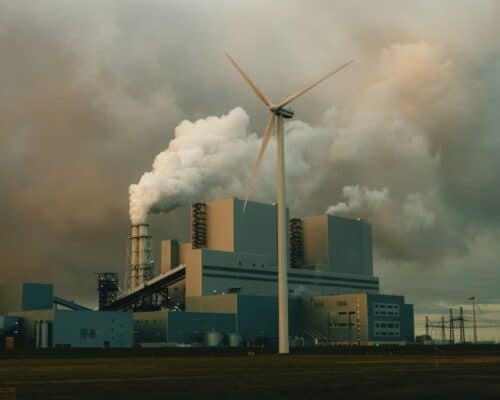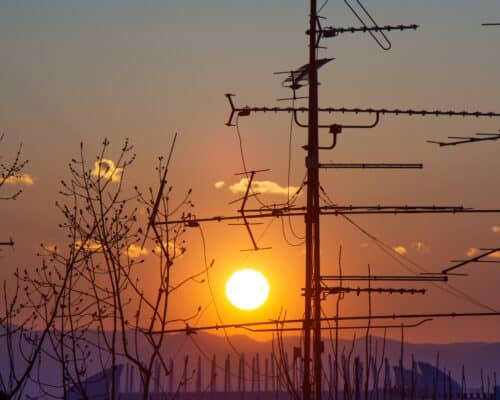Asian Countries Take Advantage of Floating Solar Power Plant
Photo: Shutterstock / Avigator Fortuner
23 January 2024 – by Retno Ayuningtyas
In November 2023, Indonesia inaugurated the Cirata Floating Solar Power Plant, which has a capacity of 192 MW and is the largest floating solar power plant in Southeast Asia. With an area covering 5% of the total surface of the reservoir, this power plant provides electricity to 50 thousand homes for 5.8 US$ cents per kilowatt hour (kWh).
Indonesia is not the only country that chose a floating solar power plant to boost its renewable energy development. Tetchi Capellan, President and CEO of SunAsia Energy, said that floating PLTS is a story of Asian countries pursuing renewable energy targets. Her home country, the Philippines, and other Asian countries, such as Malaysia and Vietnam, have also developed floating solar power plants.
“Most ASEAN countries face land problems, so floating solar power plants are a solution. The ASEAN economy will still grow by 6%; therefore, it needs a large quantity of energy. Floating solar power plant technology makes achieving a huge capacity power generation possible,” said Capellan at the ASEAN Clean Energy Week Conference and Exhibition in Manila, the Philippines, on November 21-22, 2023.
SunAsia is collaborating with Blueleaf Energy in the Philippines to build 10 floating solar power plants with a total capacity of 1,300 megawatts (MW) on Laguna Lake. In Malaysia, Tenaga Nasional Berhad plans to build 2,500 MW floating solar power plants in all reservoirs, which are also the locations for its hydroelectric power plants.
Southeast Asian countries must compete to attract investors to choose their country as an investment destination for renewable energy, including floating solar power plants.
According to Lawrence Wu, Chief Financial Officer of EDP Renewables APAC, there are two challenges in the renewable energy market: transmission readiness and market form of electricity in a country.
With its liberalised electricity distribution market, the Philippines offers renewable energy electricity tariffs, which are attractive for private developers (independent power producers/IPPs). Jason Soberano, Vice President and Chief Business Development Officer of SN Aboitiz Power Group, said that the Philippines offered different electricity prices for solar power plants built on rooftops and floating ones.
In Indonesia, which market is still strictly regulated, electricity tariffs are set by the government. Unlike the Philippines, the price of solar power plant electricity in Indonesia has no specific classification for on-land installations, rooftops, or floating on water, referring to Presidential Regulation No. 112/2022. Pricing is considered based on location and integration with batteries. However, it will still go through a negotiation process with state-owned electricity company PT PLN (Persero), which acts as the sole buyer of private electricity in Indonesia.
Eric Miller, SEA Regional Head of Business Development Levanta Renewables, assessed that electricity regulations in Indonesia are complicated, making achieving renewable energy targets challenging.
Indonesia’s success in completing the Cirata Floating Solar Power Plant is not free from regulatory complexities. The construction of this power plant had been delayed. In contrast, the procurement had to be reconducted due to the issuance of a new regulation banning direct appointment, namely Minister of Energy and Mineral Resources Regulation (Permen ESDM) No. 50/2017. After rolling back, this project was also hampered by regulations regarding the domestic content level obligations (TKDN) of 60%, where the domestic solar power plant supporting industry could not provide the necessary equipment.
Teguh Widhi Harsono, Chief Financial Officer of PT PLN Icon Plus, a PLN subsidiary, acknowledges that Indonesia has very strict electricity regulations and is entirely under the management of PLN. This is due to Indonesia’s consideration of the balance of economic growth and how clean the available energy supply is. “We need to have a backup supply of electricity for base load, while renewable energy has intermittency,” he said.
Harsono explained that PLN has transitioned from fossil to renewable energy, from large-scale centralised systems to more distributed decentralisation. One of them is increasing the number of rooftop solar panels, with an additional target of 2 gigawatts (GW) in the next two years.
However, unlike in the Philippines, which has special rates for rooftop solar panels, electricity systems in Indonesia do not recognise buying and selling electricity for rooftop solar panels. So far, the excess electricity from rooftop solar panels that enters the electricity network is only counted as a deduction from electricity bills. However, the newly drafted regulations will eliminate this provision. Rooftop solar panels are directed to meet electricity needs independently instead of entering the power grid.
Junrhey Castro, Managing Director of BayWa r.e., revealed that a country would be an investment destination if that country had a stable energy market in the long term. He specifically mentioned countries with better regulations on rooftop solar power plants. In this case, Indonesia’s energy market cannot be said to be stable.
Indonesia has set a carbon-neutral target by 2060 or sooner. Indonesia has also targeted an increase in the renewable energy mix to 23% by 2025, reaching 31.2% by 2050. In fact, in the Comprehensive Investment and Policy Document Plan (CIPP) Just Energy Transition Partnership (JETP), Indonesia aims at a more aggressive target of 44% in 2030. However, until now, the share of renewable energy in Indonesia’s electricity has only reached 15%. Indonesia must resolve financial and non-financial challenges to achieve its already determined mixed renewable energy targets.
Retno Ayuningtyas is an associate for the Just and Green Energy Transition Program at Yayasan Indonesia CERAH and a former editor at one of Indonesia’s business and finance newspapers, Investor Daily. She has ten years of experience covering the energy sector in Indonesia and joined CERAH in April 2022.
CERAH
Yayasan Indonesia Cerah, also known as CERAH, is an Indonesian non-profit organisation working to advance Indonesia’s energy transition policy agenda. CERAH combines deep energy sector knowledge, cutting-edge communications capacity, and a campaigner’s desire for change.
Disclaimer: The views and opinions expressed in this article are those of the author and do not necessarily reflect the official policy or position of Energy Tracker Asia.





